CPC50210 Diploma: Managing Construction Work Project Assessment
VerifiedAdded on 2023/03/31
|18
|5578
|395
Project
AI Summary
This document presents a solved project assessment for the CPC50210 Diploma of Building and Construction, focusing on managing construction work. It covers essential aspects such as communication procedures, site schedules, WHS policies and practices, and risk management. The solution details communication strategies including oral, written, non-verbal, and electronic methods, emphasizing the use of tools like EDMS and social messaging for efficient information sharing. A comprehensive site schedule outlines key activities and meeting agendas, while the WHS section identifies potential hazards and provides procedures for risk assessment and control. The project assessment also includes a sample email demonstrating effective communication with site personnel. This resource offers valuable insights and practical guidance for students studying construction management.
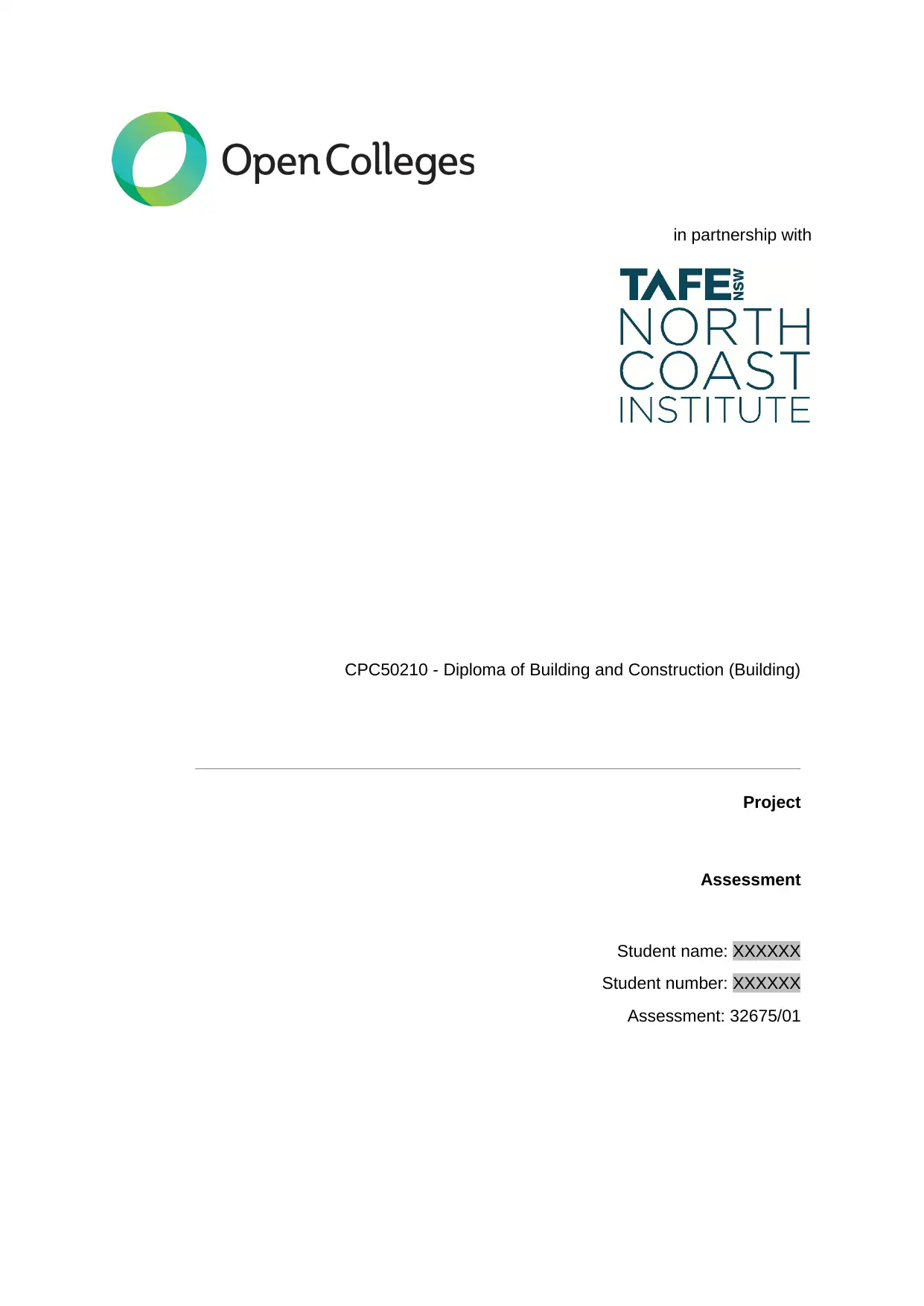
in partnership with
CPC50210 - Diploma of Building and Construction (Building)
Project
Assessment
Student name: XXXXXX
Student number: XXXXXX
Assessment: 32675/01
CPC50210 - Diploma of Building and Construction (Building)
Project
Assessment
Student name: XXXXXX
Student number: XXXXXX
Assessment: 32675/01
Paraphrase This Document
Need a fresh take? Get an instant paraphrase of this document with our AI Paraphraser
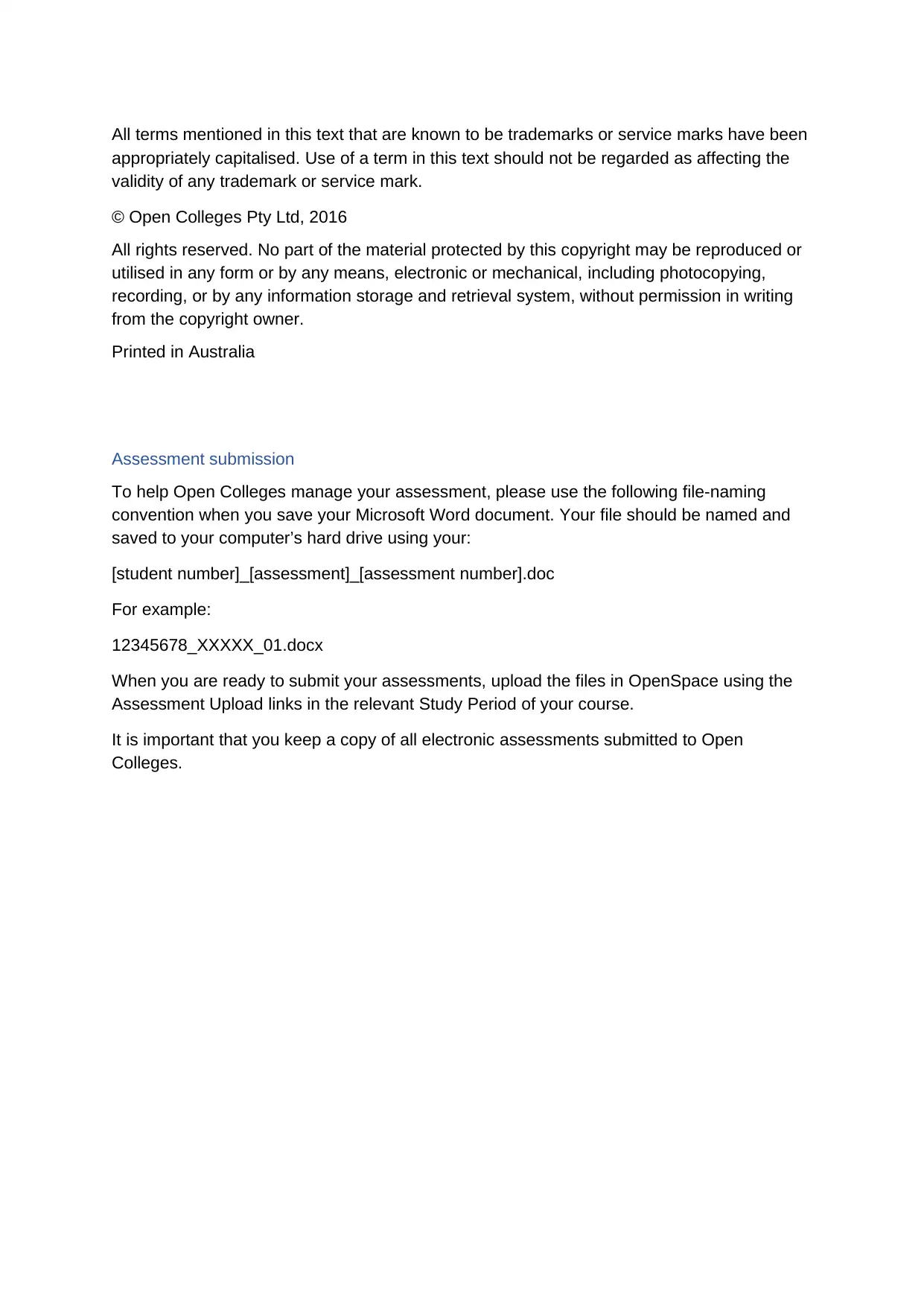
All terms mentioned in this text that are known to be trademarks or service marks have been
appropriately capitalised. Use of a term in this text should not be regarded as affecting the
validity of any trademark or service mark.
© Open Colleges Pty Ltd, 2016
All rights reserved. No part of the material protected by this copyright may be reproduced or
utilised in any form or by any means, electronic or mechanical, including photocopying,
recording, or by any information storage and retrieval system, without permission in writing
from the copyright owner.
Printed in Australia
Assessment submission
To help Open Colleges manage your assessment, please use the following file-naming
convention when you save your Microsoft Word document. Your file should be named and
saved to your computer’s hard drive using your:
[student number]_[assessment]_[assessment number].doc
For example:
12345678_XXXXX_01.docx
When you are ready to submit your assessments, upload the files in OpenSpace using the
Assessment Upload links in the relevant Study Period of your course.
It is important that you keep a copy of all electronic assessments submitted to Open
Colleges.
appropriately capitalised. Use of a term in this text should not be regarded as affecting the
validity of any trademark or service mark.
© Open Colleges Pty Ltd, 2016
All rights reserved. No part of the material protected by this copyright may be reproduced or
utilised in any form or by any means, electronic or mechanical, including photocopying,
recording, or by any information storage and retrieval system, without permission in writing
from the copyright owner.
Printed in Australia
Assessment submission
To help Open Colleges manage your assessment, please use the following file-naming
convention when you save your Microsoft Word document. Your file should be named and
saved to your computer’s hard drive using your:
[student number]_[assessment]_[assessment number].doc
For example:
12345678_XXXXX_01.docx
When you are ready to submit your assessments, upload the files in OpenSpace using the
Assessment Upload links in the relevant Study Period of your course.
It is important that you keep a copy of all electronic assessments submitted to Open
Colleges.
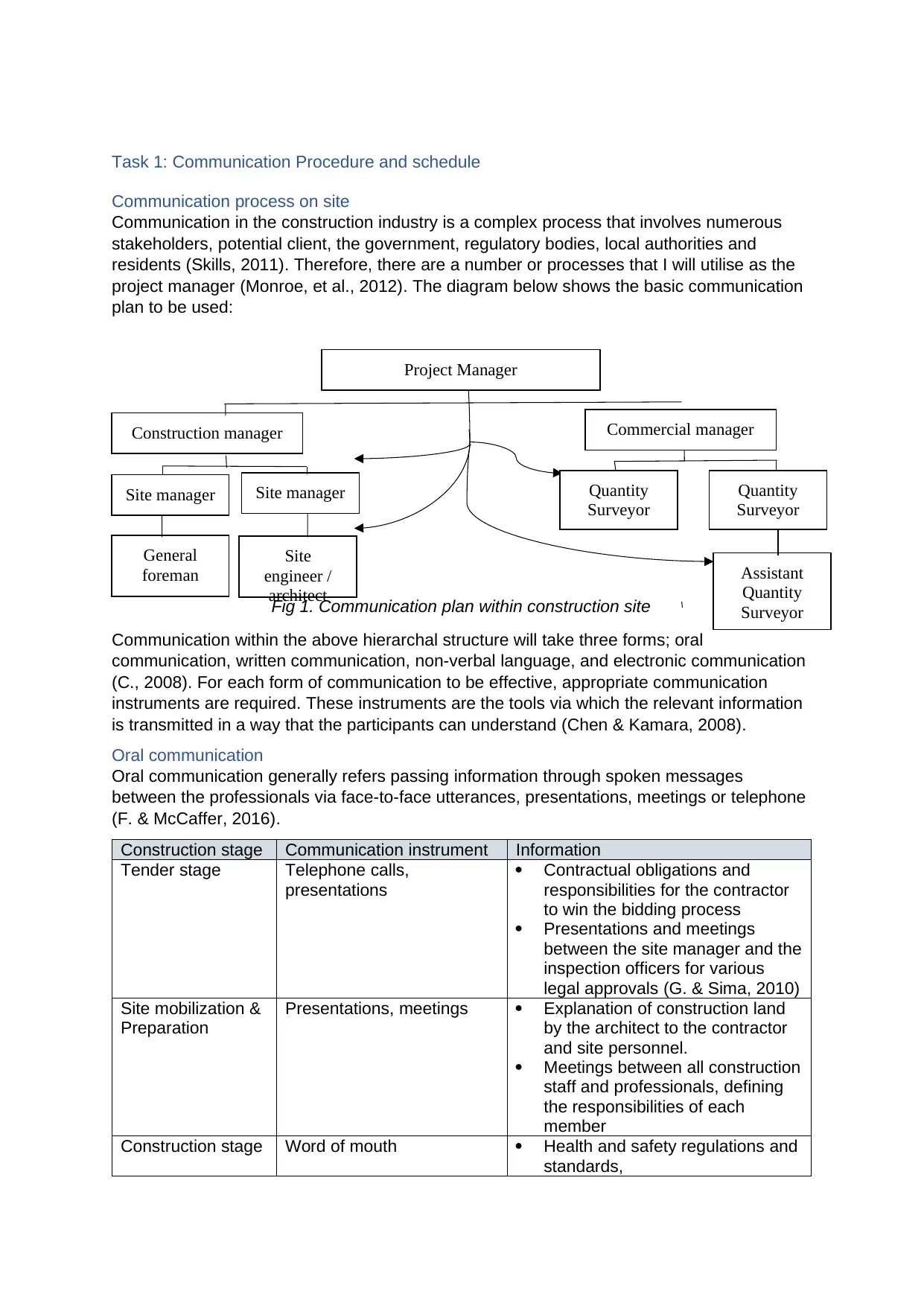
Task 1: Communication Procedure and schedule
Communication process on site
Communication in the construction industry is a complex process that involves numerous
stakeholders, potential client, the government, regulatory bodies, local authorities and
residents (Skills, 2011). Therefore, there are a number or processes that I will utilise as the
project manager (Monroe, et al., 2012). The diagram below shows the basic communication
plan to be used:
Fig 1. Communication plan within construction site
Communication within the above hierarchal structure will take three forms; oral
communication, written communication, non-verbal language, and electronic communication
(C., 2008). For each form of communication to be effective, appropriate communication
instruments are required. These instruments are the tools via which the relevant information
is transmitted in a way that the participants can understand (Chen & Kamara, 2008).
Oral communication
Oral communication generally refers passing information through spoken messages
between the professionals via face-to-face utterances, presentations, meetings or telephone
(F. & McCaffer, 2016).
Construction stage Communication instrument Information
Tender stage Telephone calls,
presentations
Contractual obligations and
responsibilities for the contractor
to win the bidding process
Presentations and meetings
between the site manager and the
inspection officers for various
legal approvals (G. & Sima, 2010)
Site mobilization &
Preparation
Presentations, meetings Explanation of construction land
by the architect to the contractor
and site personnel.
Meetings between all construction
staff and professionals, defining
the responsibilities of each
member
Construction stage Word of mouth Health and safety regulations and
standards,
Project Manager
Construction manager Commercial manager
Site manager Site manager Quantity
Surveyor
Quantity
Surveyor
General
foreman
Site
engineer /
architect
Assistant
Quantity
Surveyor
Communication process on site
Communication in the construction industry is a complex process that involves numerous
stakeholders, potential client, the government, regulatory bodies, local authorities and
residents (Skills, 2011). Therefore, there are a number or processes that I will utilise as the
project manager (Monroe, et al., 2012). The diagram below shows the basic communication
plan to be used:
Fig 1. Communication plan within construction site
Communication within the above hierarchal structure will take three forms; oral
communication, written communication, non-verbal language, and electronic communication
(C., 2008). For each form of communication to be effective, appropriate communication
instruments are required. These instruments are the tools via which the relevant information
is transmitted in a way that the participants can understand (Chen & Kamara, 2008).
Oral communication
Oral communication generally refers passing information through spoken messages
between the professionals via face-to-face utterances, presentations, meetings or telephone
(F. & McCaffer, 2016).
Construction stage Communication instrument Information
Tender stage Telephone calls,
presentations
Contractual obligations and
responsibilities for the contractor
to win the bidding process
Presentations and meetings
between the site manager and the
inspection officers for various
legal approvals (G. & Sima, 2010)
Site mobilization &
Preparation
Presentations, meetings Explanation of construction land
by the architect to the contractor
and site personnel.
Meetings between all construction
staff and professionals, defining
the responsibilities of each
member
Construction stage Word of mouth Health and safety regulations and
standards,
Project Manager
Construction manager Commercial manager
Site manager Site manager Quantity
Surveyor
Quantity
Surveyor
General
foreman
Site
engineer /
architect
Assistant
Quantity
Surveyor
⊘ This is a preview!⊘
Do you want full access?
Subscribe today to unlock all pages.

Trusted by 1+ million students worldwide
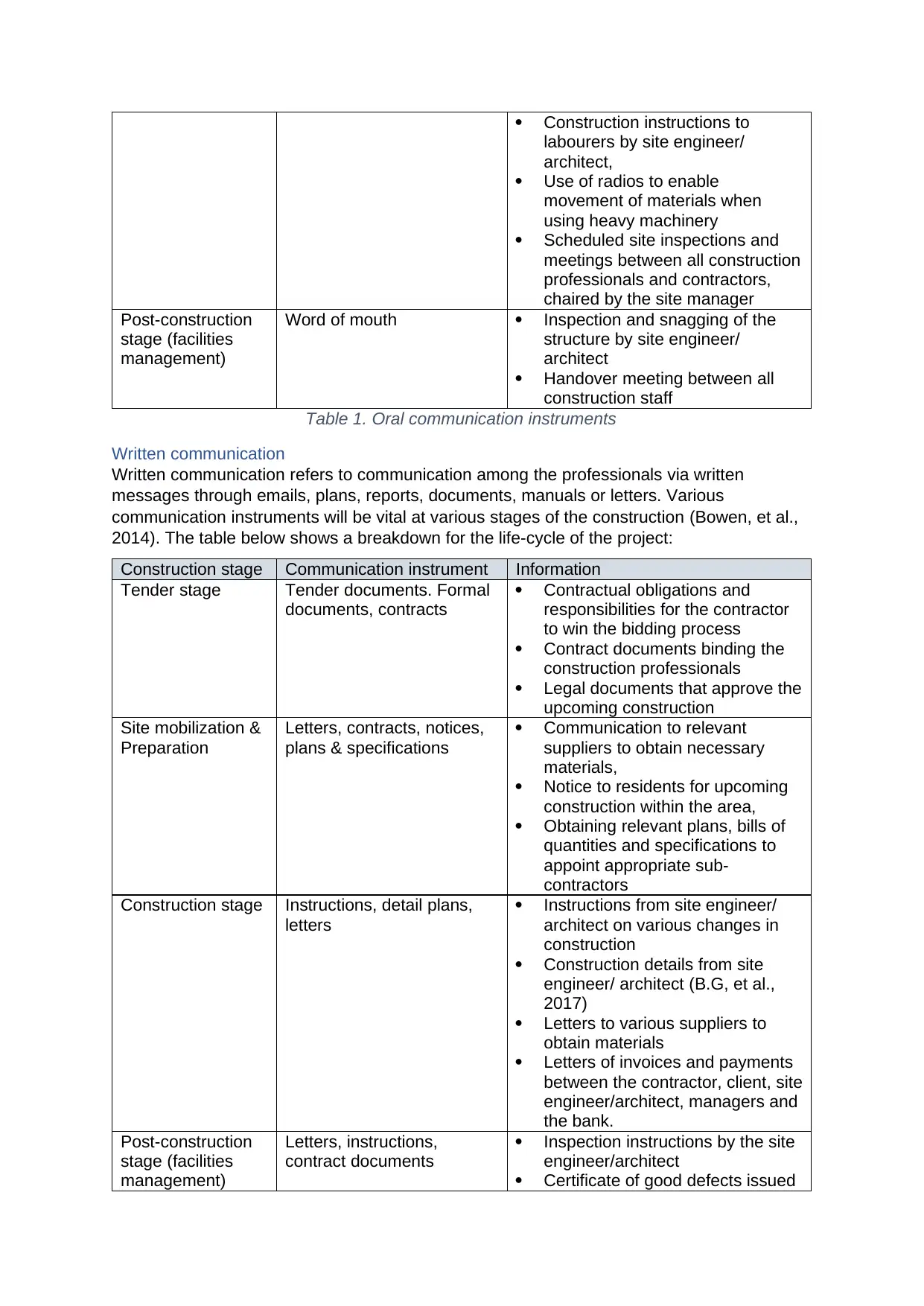
Construction instructions to
labourers by site engineer/
architect,
Use of radios to enable
movement of materials when
using heavy machinery
Scheduled site inspections and
meetings between all construction
professionals and contractors,
chaired by the site manager
Post-construction
stage (facilities
management)
Word of mouth Inspection and snagging of the
structure by site engineer/
architect
Handover meeting between all
construction staff
Table 1. Oral communication instruments
Written communication
Written communication refers to communication among the professionals via written
messages through emails, plans, reports, documents, manuals or letters. Various
communication instruments will be vital at various stages of the construction (Bowen, et al.,
2014). The table below shows a breakdown for the life-cycle of the project:
Construction stage Communication instrument Information
Tender stage Tender documents. Formal
documents, contracts
Contractual obligations and
responsibilities for the contractor
to win the bidding process
Contract documents binding the
construction professionals
Legal documents that approve the
upcoming construction
Site mobilization &
Preparation
Letters, contracts, notices,
plans & specifications
Communication to relevant
suppliers to obtain necessary
materials,
Notice to residents for upcoming
construction within the area,
Obtaining relevant plans, bills of
quantities and specifications to
appoint appropriate sub-
contractors
Construction stage Instructions, detail plans,
letters
Instructions from site engineer/
architect on various changes in
construction
Construction details from site
engineer/ architect (B.G, et al.,
2017)
Letters to various suppliers to
obtain materials
Letters of invoices and payments
between the contractor, client, site
engineer/architect, managers and
the bank.
Post-construction
stage (facilities
management)
Letters, instructions,
contract documents
Inspection instructions by the site
engineer/architect
Certificate of good defects issued
labourers by site engineer/
architect,
Use of radios to enable
movement of materials when
using heavy machinery
Scheduled site inspections and
meetings between all construction
professionals and contractors,
chaired by the site manager
Post-construction
stage (facilities
management)
Word of mouth Inspection and snagging of the
structure by site engineer/
architect
Handover meeting between all
construction staff
Table 1. Oral communication instruments
Written communication
Written communication refers to communication among the professionals via written
messages through emails, plans, reports, documents, manuals or letters. Various
communication instruments will be vital at various stages of the construction (Bowen, et al.,
2014). The table below shows a breakdown for the life-cycle of the project:
Construction stage Communication instrument Information
Tender stage Tender documents. Formal
documents, contracts
Contractual obligations and
responsibilities for the contractor
to win the bidding process
Contract documents binding the
construction professionals
Legal documents that approve the
upcoming construction
Site mobilization &
Preparation
Letters, contracts, notices,
plans & specifications
Communication to relevant
suppliers to obtain necessary
materials,
Notice to residents for upcoming
construction within the area,
Obtaining relevant plans, bills of
quantities and specifications to
appoint appropriate sub-
contractors
Construction stage Instructions, detail plans,
letters
Instructions from site engineer/
architect on various changes in
construction
Construction details from site
engineer/ architect (B.G, et al.,
2017)
Letters to various suppliers to
obtain materials
Letters of invoices and payments
between the contractor, client, site
engineer/architect, managers and
the bank.
Post-construction
stage (facilities
management)
Letters, instructions,
contract documents
Inspection instructions by the site
engineer/architect
Certificate of good defects issued
Paraphrase This Document
Need a fresh take? Get an instant paraphrase of this document with our AI Paraphraser
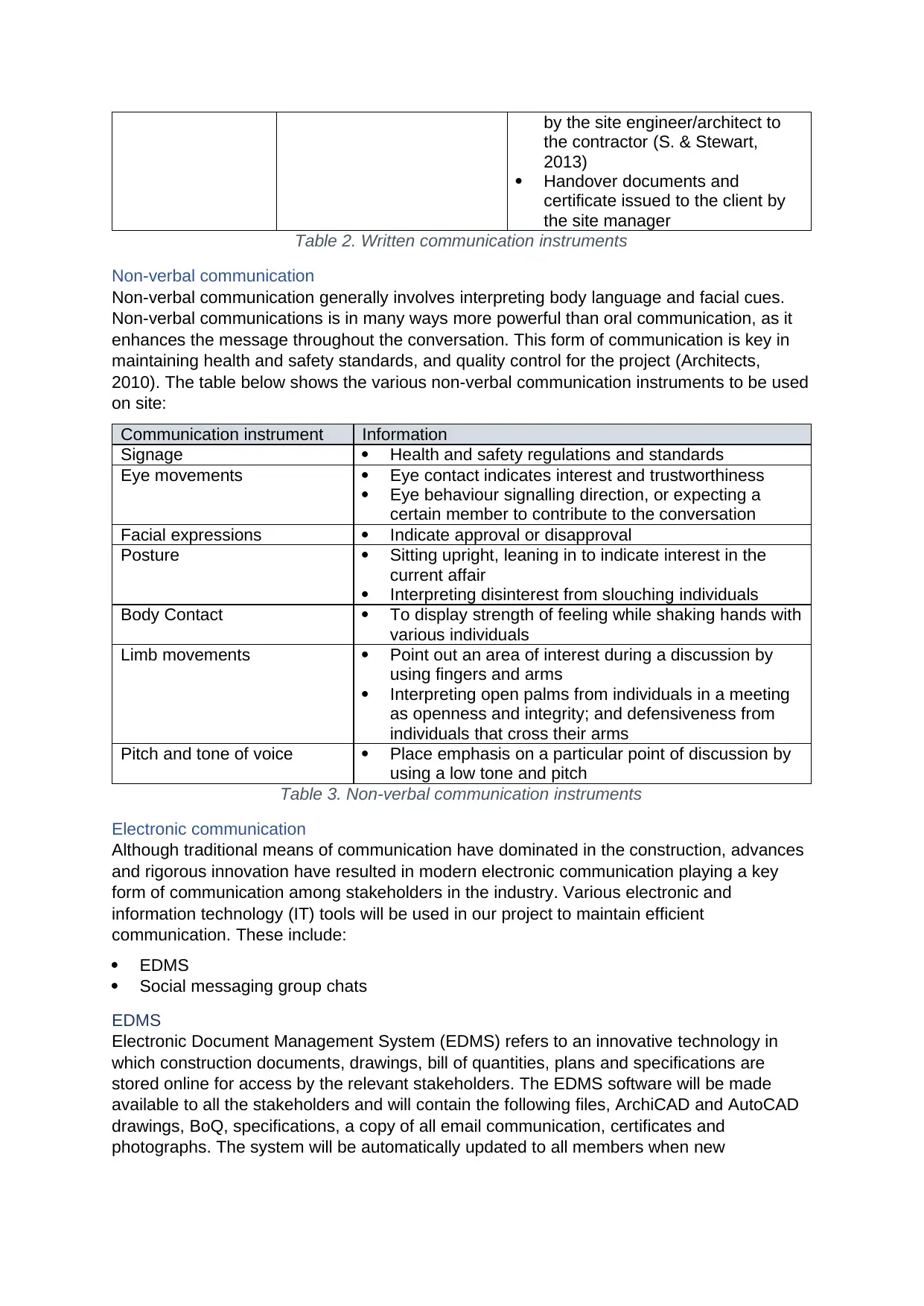
by the site engineer/architect to
the contractor (S. & Stewart,
2013)
Handover documents and
certificate issued to the client by
the site manager
Table 2. Written communication instruments
Non-verbal communication
Non-verbal communication generally involves interpreting body language and facial cues.
Non-verbal communications is in many ways more powerful than oral communication, as it
enhances the message throughout the conversation. This form of communication is key in
maintaining health and safety standards, and quality control for the project (Architects,
2010). The table below shows the various non-verbal communication instruments to be used
on site:
Communication instrument Information
Signage Health and safety regulations and standards
Eye movements Eye contact indicates interest and trustworthiness
Eye behaviour signalling direction, or expecting a
certain member to contribute to the conversation
Facial expressions Indicate approval or disapproval
Posture Sitting upright, leaning in to indicate interest in the
current affair
Interpreting disinterest from slouching individuals
Body Contact To display strength of feeling while shaking hands with
various individuals
Limb movements Point out an area of interest during a discussion by
using fingers and arms
Interpreting open palms from individuals in a meeting
as openness and integrity; and defensiveness from
individuals that cross their arms
Pitch and tone of voice Place emphasis on a particular point of discussion by
using a low tone and pitch
Table 3. Non-verbal communication instruments
Electronic communication
Although traditional means of communication have dominated in the construction, advances
and rigorous innovation have resulted in modern electronic communication playing a key
form of communication among stakeholders in the industry. Various electronic and
information technology (IT) tools will be used in our project to maintain efficient
communication. These include:
EDMS
Social messaging group chats
EDMS
Electronic Document Management System (EDMS) refers to an innovative technology in
which construction documents, drawings, bill of quantities, plans and specifications are
stored online for access by the relevant stakeholders. The EDMS software will be made
available to all the stakeholders and will contain the following files, ArchiCAD and AutoCAD
drawings, BoQ, specifications, a copy of all email communication, certificates and
photographs. The system will be automatically updated to all members when new
the contractor (S. & Stewart,
2013)
Handover documents and
certificate issued to the client by
the site manager
Table 2. Written communication instruments
Non-verbal communication
Non-verbal communication generally involves interpreting body language and facial cues.
Non-verbal communications is in many ways more powerful than oral communication, as it
enhances the message throughout the conversation. This form of communication is key in
maintaining health and safety standards, and quality control for the project (Architects,
2010). The table below shows the various non-verbal communication instruments to be used
on site:
Communication instrument Information
Signage Health and safety regulations and standards
Eye movements Eye contact indicates interest and trustworthiness
Eye behaviour signalling direction, or expecting a
certain member to contribute to the conversation
Facial expressions Indicate approval or disapproval
Posture Sitting upright, leaning in to indicate interest in the
current affair
Interpreting disinterest from slouching individuals
Body Contact To display strength of feeling while shaking hands with
various individuals
Limb movements Point out an area of interest during a discussion by
using fingers and arms
Interpreting open palms from individuals in a meeting
as openness and integrity; and defensiveness from
individuals that cross their arms
Pitch and tone of voice Place emphasis on a particular point of discussion by
using a low tone and pitch
Table 3. Non-verbal communication instruments
Electronic communication
Although traditional means of communication have dominated in the construction, advances
and rigorous innovation have resulted in modern electronic communication playing a key
form of communication among stakeholders in the industry. Various electronic and
information technology (IT) tools will be used in our project to maintain efficient
communication. These include:
EDMS
Social messaging group chats
EDMS
Electronic Document Management System (EDMS) refers to an innovative technology in
which construction documents, drawings, bill of quantities, plans and specifications are
stored online for access by the relevant stakeholders. The EDMS software will be made
available to all the stakeholders and will contain the following files, ArchiCAD and AutoCAD
drawings, BoQ, specifications, a copy of all email communication, certificates and
photographs. The system will be automatically updated to all members when new
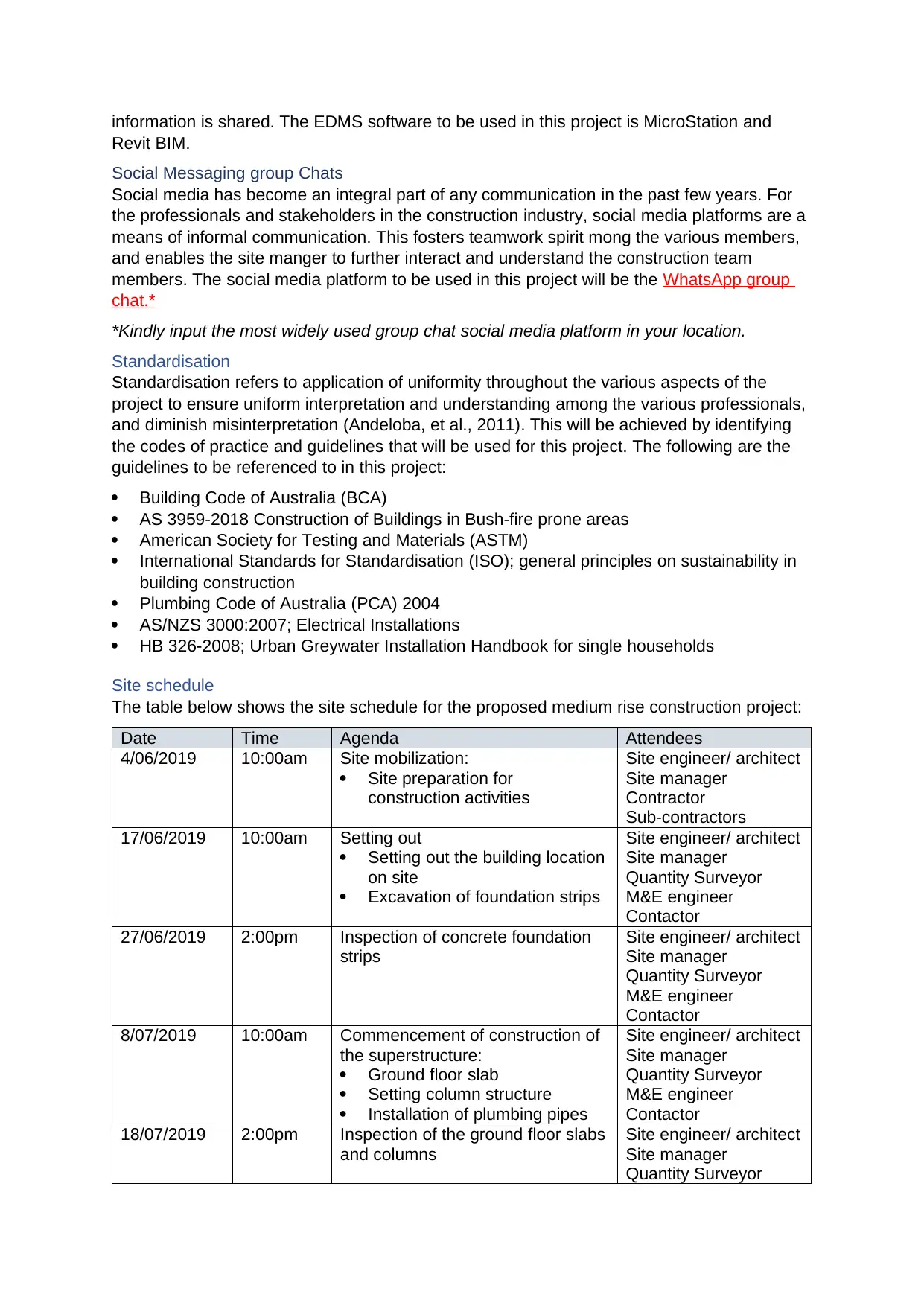
information is shared. The EDMS software to be used in this project is MicroStation and
Revit BIM.
Social Messaging group Chats
Social media has become an integral part of any communication in the past few years. For
the professionals and stakeholders in the construction industry, social media platforms are a
means of informal communication. This fosters teamwork spirit mong the various members,
and enables the site manger to further interact and understand the construction team
members. The social media platform to be used in this project will be the WhatsApp group
chat.*
*Kindly input the most widely used group chat social media platform in your location.
Standardisation
Standardisation refers to application of uniformity throughout the various aspects of the
project to ensure uniform interpretation and understanding among the various professionals,
and diminish misinterpretation (Andeloba, et al., 2011). This will be achieved by identifying
the codes of practice and guidelines that will be used for this project. The following are the
guidelines to be referenced to in this project:
Building Code of Australia (BCA)
AS 3959-2018 Construction of Buildings in Bush-fire prone areas
American Society for Testing and Materials (ASTM)
International Standards for Standardisation (ISO); general principles on sustainability in
building construction
Plumbing Code of Australia (PCA) 2004
AS/NZS 3000:2007; Electrical Installations
HB 326-2008; Urban Greywater Installation Handbook for single households
Site schedule
The table below shows the site schedule for the proposed medium rise construction project:
Date Time Agenda Attendees
4/06/2019 10:00am Site mobilization:
Site preparation for
construction activities
Site engineer/ architect
Site manager
Contractor
Sub-contractors
17/06/2019 10:00am Setting out
Setting out the building location
on site
Excavation of foundation strips
Site engineer/ architect
Site manager
Quantity Surveyor
M&E engineer
Contactor
27/06/2019 2:00pm Inspection of concrete foundation
strips
Site engineer/ architect
Site manager
Quantity Surveyor
M&E engineer
Contactor
8/07/2019 10:00am Commencement of construction of
the superstructure:
Ground floor slab
Setting column structure
Installation of plumbing pipes
Site engineer/ architect
Site manager
Quantity Surveyor
M&E engineer
Contactor
18/07/2019 2:00pm Inspection of the ground floor slabs
and columns
Site engineer/ architect
Site manager
Quantity Surveyor
Revit BIM.
Social Messaging group Chats
Social media has become an integral part of any communication in the past few years. For
the professionals and stakeholders in the construction industry, social media platforms are a
means of informal communication. This fosters teamwork spirit mong the various members,
and enables the site manger to further interact and understand the construction team
members. The social media platform to be used in this project will be the WhatsApp group
chat.*
*Kindly input the most widely used group chat social media platform in your location.
Standardisation
Standardisation refers to application of uniformity throughout the various aspects of the
project to ensure uniform interpretation and understanding among the various professionals,
and diminish misinterpretation (Andeloba, et al., 2011). This will be achieved by identifying
the codes of practice and guidelines that will be used for this project. The following are the
guidelines to be referenced to in this project:
Building Code of Australia (BCA)
AS 3959-2018 Construction of Buildings in Bush-fire prone areas
American Society for Testing and Materials (ASTM)
International Standards for Standardisation (ISO); general principles on sustainability in
building construction
Plumbing Code of Australia (PCA) 2004
AS/NZS 3000:2007; Electrical Installations
HB 326-2008; Urban Greywater Installation Handbook for single households
Site schedule
The table below shows the site schedule for the proposed medium rise construction project:
Date Time Agenda Attendees
4/06/2019 10:00am Site mobilization:
Site preparation for
construction activities
Site engineer/ architect
Site manager
Contractor
Sub-contractors
17/06/2019 10:00am Setting out
Setting out the building location
on site
Excavation of foundation strips
Site engineer/ architect
Site manager
Quantity Surveyor
M&E engineer
Contactor
27/06/2019 2:00pm Inspection of concrete foundation
strips
Site engineer/ architect
Site manager
Quantity Surveyor
M&E engineer
Contactor
8/07/2019 10:00am Commencement of construction of
the superstructure:
Ground floor slab
Setting column structure
Installation of plumbing pipes
Site engineer/ architect
Site manager
Quantity Surveyor
M&E engineer
Contactor
18/07/2019 2:00pm Inspection of the ground floor slabs
and columns
Site engineer/ architect
Site manager
Quantity Surveyor
⊘ This is a preview!⊘
Do you want full access?
Subscribe today to unlock all pages.

Trusted by 1+ million students worldwide
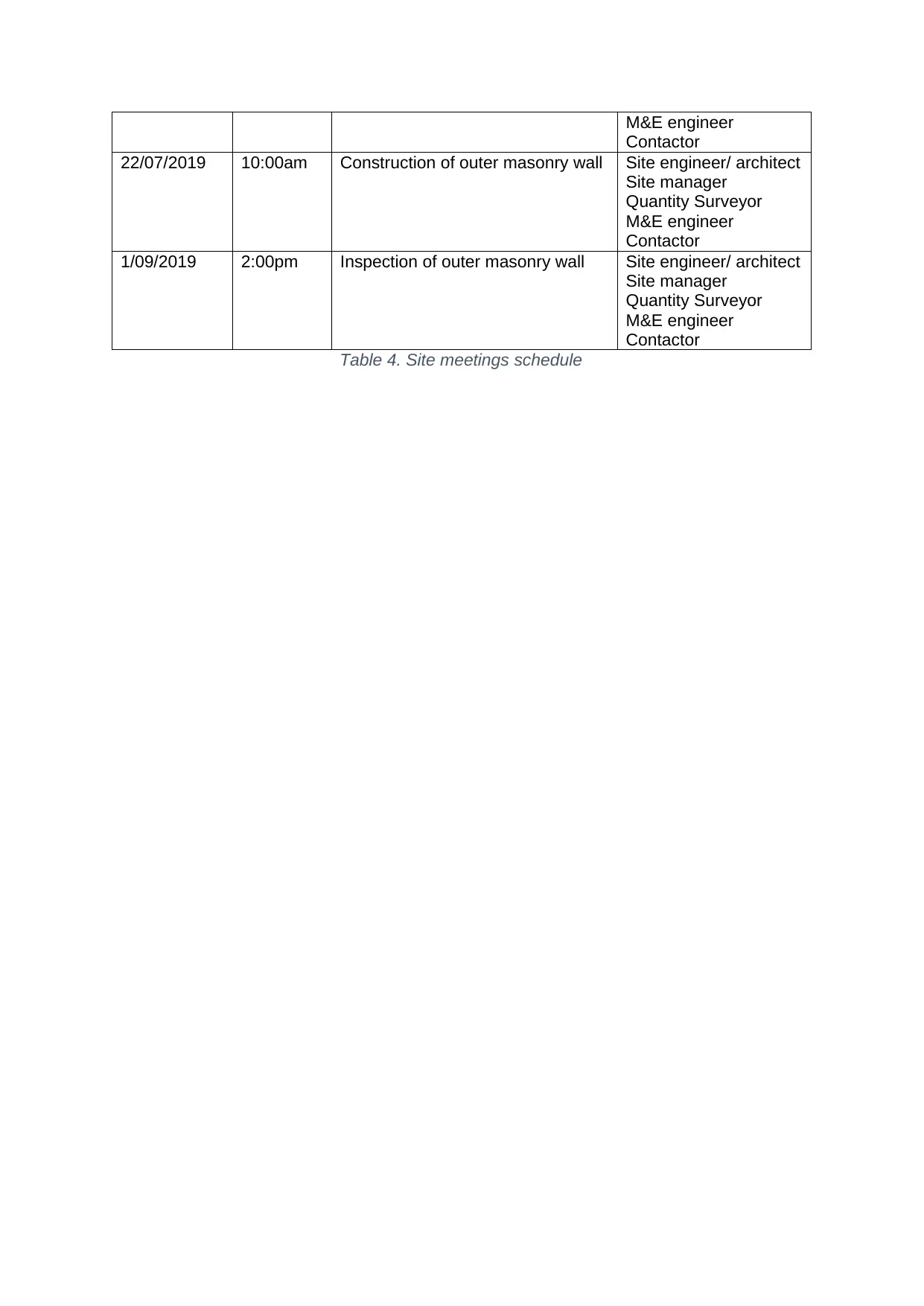
M&E engineer
Contactor
22/07/2019 10:00am Construction of outer masonry wall Site engineer/ architect
Site manager
Quantity Surveyor
M&E engineer
Contactor
1/09/2019 2:00pm Inspection of outer masonry wall Site engineer/ architect
Site manager
Quantity Surveyor
M&E engineer
Contactor
Table 4. Site meetings schedule
Contactor
22/07/2019 10:00am Construction of outer masonry wall Site engineer/ architect
Site manager
Quantity Surveyor
M&E engineer
Contactor
1/09/2019 2:00pm Inspection of outer masonry wall Site engineer/ architect
Site manager
Quantity Surveyor
M&E engineer
Contactor
Table 4. Site meetings schedule
Paraphrase This Document
Need a fresh take? Get an instant paraphrase of this document with our AI Paraphraser
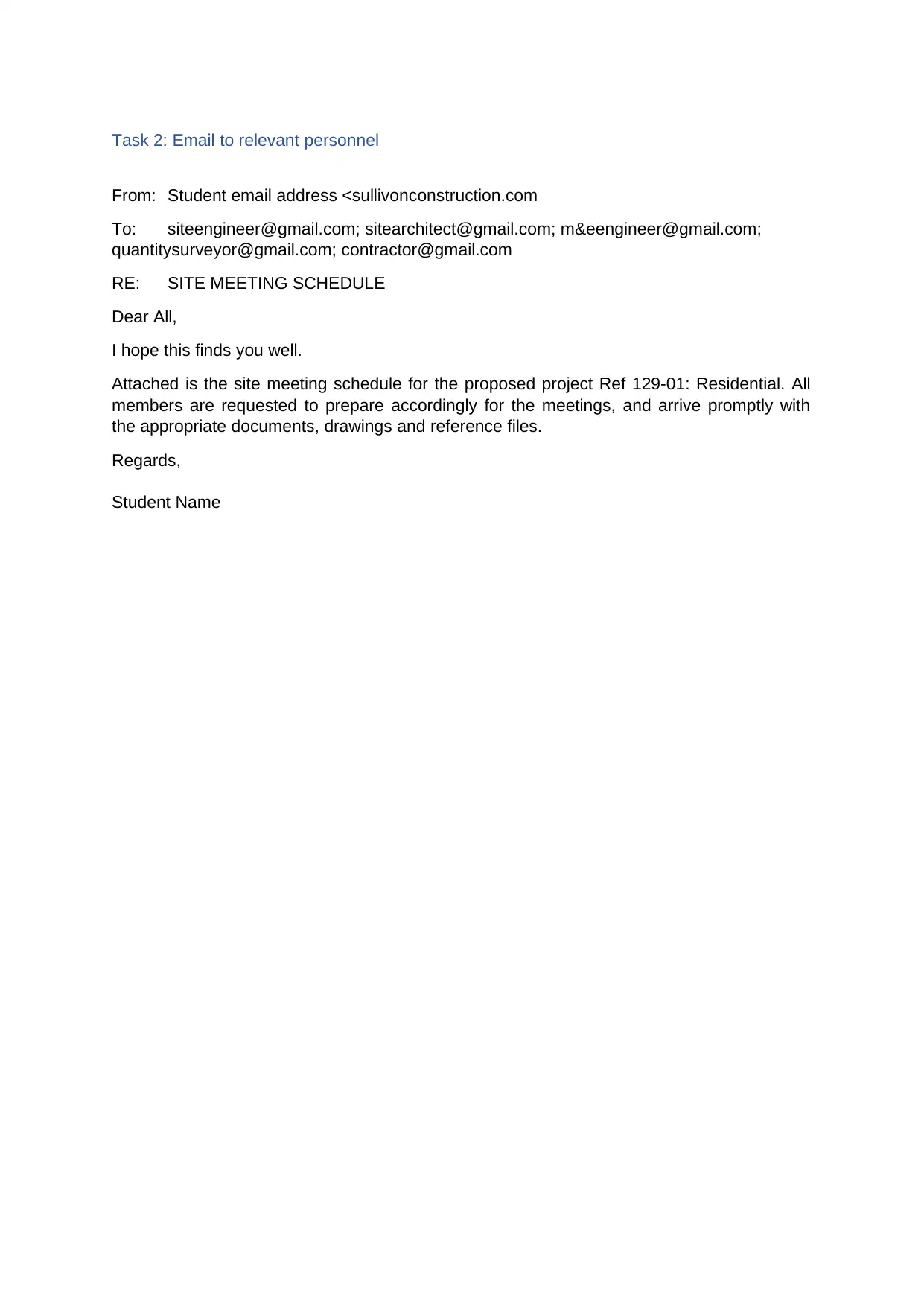
Task 2: Email to relevant personnel
From: Student email address <sullivonconstruction.com
To: siteengineer@gmail.com; sitearchitect@gmail.com; m&eengineer@gmail.com;
quantitysurveyor@gmail.com; contractor@gmail.com
RE: SITE MEETING SCHEDULE
Dear All,
I hope this finds you well.
Attached is the site meeting schedule for the proposed project Ref 129-01: Residential. All
members are requested to prepare accordingly for the meetings, and arrive promptly with
the appropriate documents, drawings and reference files.
Regards,
Student Name
From: Student email address <sullivonconstruction.com
To: siteengineer@gmail.com; sitearchitect@gmail.com; m&eengineer@gmail.com;
quantitysurveyor@gmail.com; contractor@gmail.com
RE: SITE MEETING SCHEDULE
Dear All,
I hope this finds you well.
Attached is the site meeting schedule for the proposed project Ref 129-01: Residential. All
members are requested to prepare accordingly for the meetings, and arrive promptly with
the appropriate documents, drawings and reference files.
Regards,
Student Name
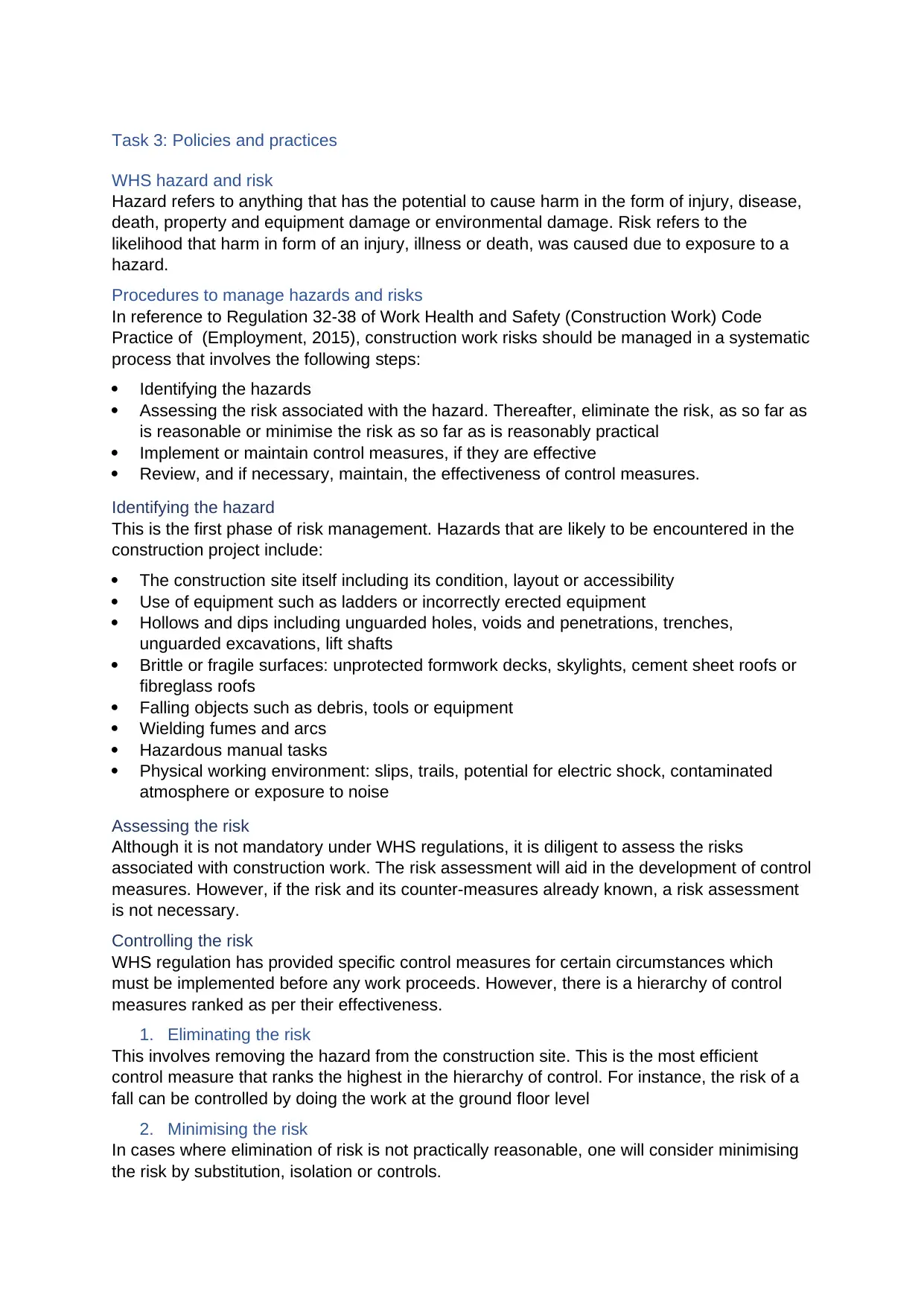
Task 3: Policies and practices
WHS hazard and risk
Hazard refers to anything that has the potential to cause harm in the form of injury, disease,
death, property and equipment damage or environmental damage. Risk refers to the
likelihood that harm in form of an injury, illness or death, was caused due to exposure to a
hazard.
Procedures to manage hazards and risks
In reference to Regulation 32-38 of Work Health and Safety (Construction Work) Code
Practice of (Employment, 2015), construction work risks should be managed in a systematic
process that involves the following steps:
Identifying the hazards
Assessing the risk associated with the hazard. Thereafter, eliminate the risk, as so far as
is reasonable or minimise the risk as so far as is reasonably practical
Implement or maintain control measures, if they are effective
Review, and if necessary, maintain, the effectiveness of control measures.
Identifying the hazard
This is the first phase of risk management. Hazards that are likely to be encountered in the
construction project include:
The construction site itself including its condition, layout or accessibility
Use of equipment such as ladders or incorrectly erected equipment
Hollows and dips including unguarded holes, voids and penetrations, trenches,
unguarded excavations, lift shafts
Brittle or fragile surfaces: unprotected formwork decks, skylights, cement sheet roofs or
fibreglass roofs
Falling objects such as debris, tools or equipment
Wielding fumes and arcs
Hazardous manual tasks
Physical working environment: slips, trails, potential for electric shock, contaminated
atmosphere or exposure to noise
Assessing the risk
Although it is not mandatory under WHS regulations, it is diligent to assess the risks
associated with construction work. The risk assessment will aid in the development of control
measures. However, if the risk and its counter-measures already known, a risk assessment
is not necessary.
Controlling the risk
WHS regulation has provided specific control measures for certain circumstances which
must be implemented before any work proceeds. However, there is a hierarchy of control
measures ranked as per their effectiveness.
1. Eliminating the risk
This involves removing the hazard from the construction site. This is the most efficient
control measure that ranks the highest in the hierarchy of control. For instance, the risk of a
fall can be controlled by doing the work at the ground floor level
2. Minimising the risk
In cases where elimination of risk is not practically reasonable, one will consider minimising
the risk by substitution, isolation or controls.
WHS hazard and risk
Hazard refers to anything that has the potential to cause harm in the form of injury, disease,
death, property and equipment damage or environmental damage. Risk refers to the
likelihood that harm in form of an injury, illness or death, was caused due to exposure to a
hazard.
Procedures to manage hazards and risks
In reference to Regulation 32-38 of Work Health and Safety (Construction Work) Code
Practice of (Employment, 2015), construction work risks should be managed in a systematic
process that involves the following steps:
Identifying the hazards
Assessing the risk associated with the hazard. Thereafter, eliminate the risk, as so far as
is reasonable or minimise the risk as so far as is reasonably practical
Implement or maintain control measures, if they are effective
Review, and if necessary, maintain, the effectiveness of control measures.
Identifying the hazard
This is the first phase of risk management. Hazards that are likely to be encountered in the
construction project include:
The construction site itself including its condition, layout or accessibility
Use of equipment such as ladders or incorrectly erected equipment
Hollows and dips including unguarded holes, voids and penetrations, trenches,
unguarded excavations, lift shafts
Brittle or fragile surfaces: unprotected formwork decks, skylights, cement sheet roofs or
fibreglass roofs
Falling objects such as debris, tools or equipment
Wielding fumes and arcs
Hazardous manual tasks
Physical working environment: slips, trails, potential for electric shock, contaminated
atmosphere or exposure to noise
Assessing the risk
Although it is not mandatory under WHS regulations, it is diligent to assess the risks
associated with construction work. The risk assessment will aid in the development of control
measures. However, if the risk and its counter-measures already known, a risk assessment
is not necessary.
Controlling the risk
WHS regulation has provided specific control measures for certain circumstances which
must be implemented before any work proceeds. However, there is a hierarchy of control
measures ranked as per their effectiveness.
1. Eliminating the risk
This involves removing the hazard from the construction site. This is the most efficient
control measure that ranks the highest in the hierarchy of control. For instance, the risk of a
fall can be controlled by doing the work at the ground floor level
2. Minimising the risk
In cases where elimination of risk is not practically reasonable, one will consider minimising
the risk by substitution, isolation or controls.
⊘ This is a preview!⊘
Do you want full access?
Subscribe today to unlock all pages.

Trusted by 1+ million students worldwide
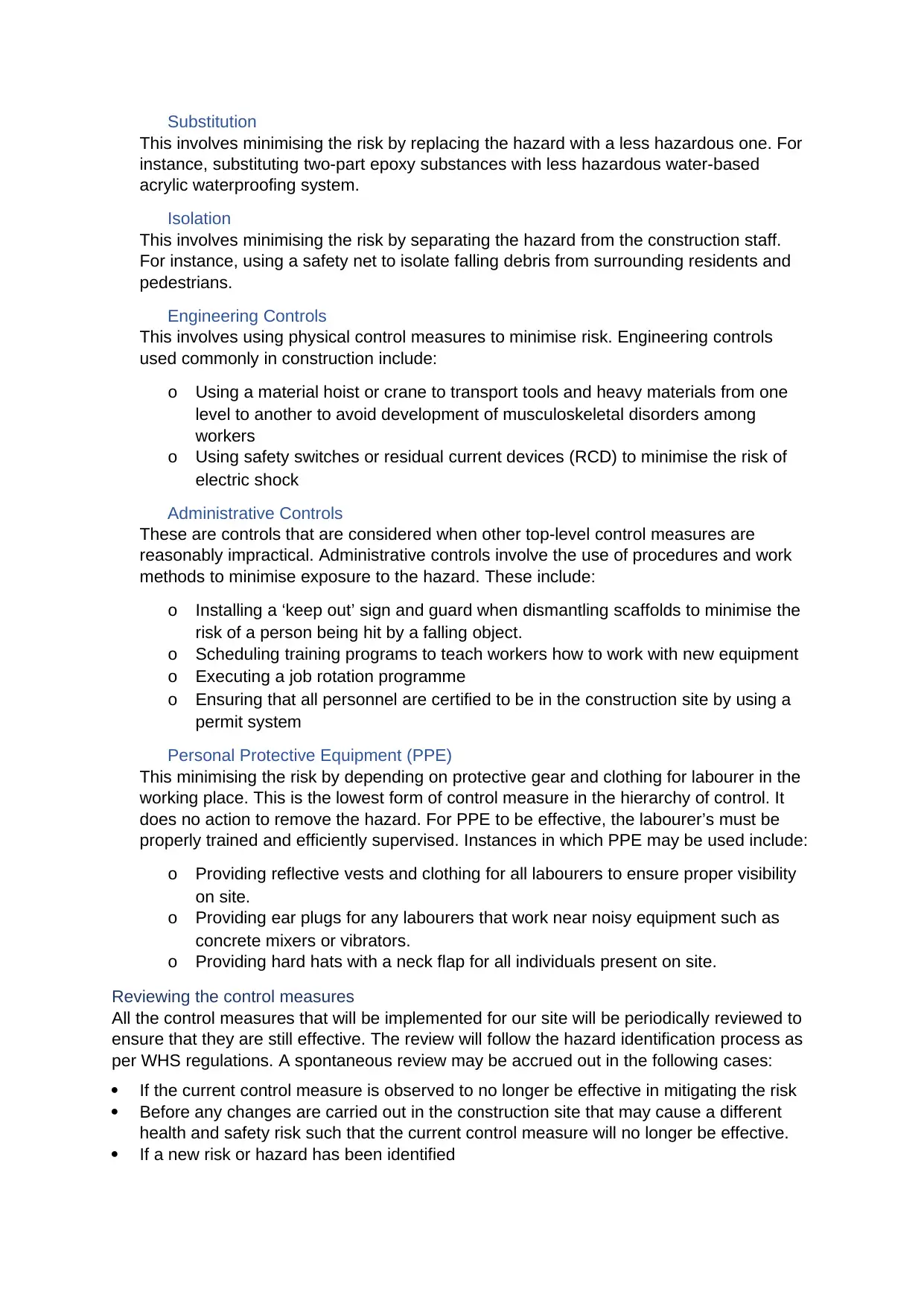
Substitution
This involves minimising the risk by replacing the hazard with a less hazardous one. For
instance, substituting two-part epoxy substances with less hazardous water-based
acrylic waterproofing system.
Isolation
This involves minimising the risk by separating the hazard from the construction staff.
For instance, using a safety net to isolate falling debris from surrounding residents and
pedestrians.
Engineering Controls
This involves using physical control measures to minimise risk. Engineering controls
used commonly in construction include:
o Using a material hoist or crane to transport tools and heavy materials from one
level to another to avoid development of musculoskeletal disorders among
workers
o Using safety switches or residual current devices (RCD) to minimise the risk of
electric shock
Administrative Controls
These are controls that are considered when other top-level control measures are
reasonably impractical. Administrative controls involve the use of procedures and work
methods to minimise exposure to the hazard. These include:
o Installing a ‘keep out’ sign and guard when dismantling scaffolds to minimise the
risk of a person being hit by a falling object.
o Scheduling training programs to teach workers how to work with new equipment
o Executing a job rotation programme
o Ensuring that all personnel are certified to be in the construction site by using a
permit system
Personal Protective Equipment (PPE)
This minimising the risk by depending on protective gear and clothing for labourer in the
working place. This is the lowest form of control measure in the hierarchy of control. It
does no action to remove the hazard. For PPE to be effective, the labourer’s must be
properly trained and efficiently supervised. Instances in which PPE may be used include:
o Providing reflective vests and clothing for all labourers to ensure proper visibility
on site.
o Providing ear plugs for any labourers that work near noisy equipment such as
concrete mixers or vibrators.
o Providing hard hats with a neck flap for all individuals present on site.
Reviewing the control measures
All the control measures that will be implemented for our site will be periodically reviewed to
ensure that they are still effective. The review will follow the hazard identification process as
per WHS regulations. A spontaneous review may be accrued out in the following cases:
If the current control measure is observed to no longer be effective in mitigating the risk
Before any changes are carried out in the construction site that may cause a different
health and safety risk such that the current control measure will no longer be effective.
If a new risk or hazard has been identified
This involves minimising the risk by replacing the hazard with a less hazardous one. For
instance, substituting two-part epoxy substances with less hazardous water-based
acrylic waterproofing system.
Isolation
This involves minimising the risk by separating the hazard from the construction staff.
For instance, using a safety net to isolate falling debris from surrounding residents and
pedestrians.
Engineering Controls
This involves using physical control measures to minimise risk. Engineering controls
used commonly in construction include:
o Using a material hoist or crane to transport tools and heavy materials from one
level to another to avoid development of musculoskeletal disorders among
workers
o Using safety switches or residual current devices (RCD) to minimise the risk of
electric shock
Administrative Controls
These are controls that are considered when other top-level control measures are
reasonably impractical. Administrative controls involve the use of procedures and work
methods to minimise exposure to the hazard. These include:
o Installing a ‘keep out’ sign and guard when dismantling scaffolds to minimise the
risk of a person being hit by a falling object.
o Scheduling training programs to teach workers how to work with new equipment
o Executing a job rotation programme
o Ensuring that all personnel are certified to be in the construction site by using a
permit system
Personal Protective Equipment (PPE)
This minimising the risk by depending on protective gear and clothing for labourer in the
working place. This is the lowest form of control measure in the hierarchy of control. It
does no action to remove the hazard. For PPE to be effective, the labourer’s must be
properly trained and efficiently supervised. Instances in which PPE may be used include:
o Providing reflective vests and clothing for all labourers to ensure proper visibility
on site.
o Providing ear plugs for any labourers that work near noisy equipment such as
concrete mixers or vibrators.
o Providing hard hats with a neck flap for all individuals present on site.
Reviewing the control measures
All the control measures that will be implemented for our site will be periodically reviewed to
ensure that they are still effective. The review will follow the hazard identification process as
per WHS regulations. A spontaneous review may be accrued out in the following cases:
If the current control measure is observed to no longer be effective in mitigating the risk
Before any changes are carried out in the construction site that may cause a different
health and safety risk such that the current control measure will no longer be effective.
If a new risk or hazard has been identified
Paraphrase This Document
Need a fresh take? Get an instant paraphrase of this document with our AI Paraphraser
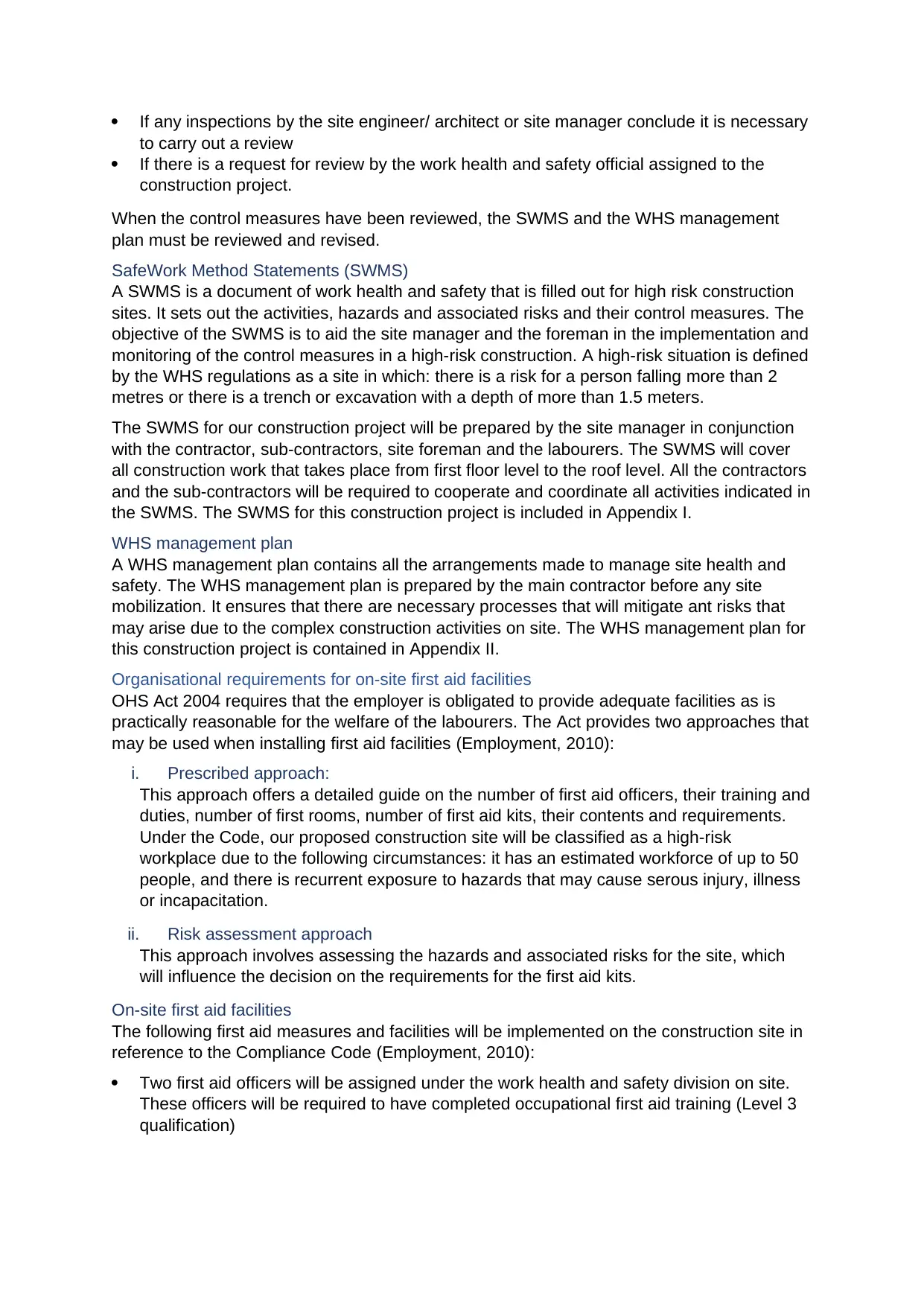
If any inspections by the site engineer/ architect or site manager conclude it is necessary
to carry out a review
If there is a request for review by the work health and safety official assigned to the
construction project.
When the control measures have been reviewed, the SWMS and the WHS management
plan must be reviewed and revised.
SafeWork Method Statements (SWMS)
A SWMS is a document of work health and safety that is filled out for high risk construction
sites. It sets out the activities, hazards and associated risks and their control measures. The
objective of the SWMS is to aid the site manager and the foreman in the implementation and
monitoring of the control measures in a high-risk construction. A high-risk situation is defined
by the WHS regulations as a site in which: there is a risk for a person falling more than 2
metres or there is a trench or excavation with a depth of more than 1.5 meters.
The SWMS for our construction project will be prepared by the site manager in conjunction
with the contractor, sub-contractors, site foreman and the labourers. The SWMS will cover
all construction work that takes place from first floor level to the roof level. All the contractors
and the sub-contractors will be required to cooperate and coordinate all activities indicated in
the SWMS. The SWMS for this construction project is included in Appendix I.
WHS management plan
A WHS management plan contains all the arrangements made to manage site health and
safety. The WHS management plan is prepared by the main contractor before any site
mobilization. It ensures that there are necessary processes that will mitigate ant risks that
may arise due to the complex construction activities on site. The WHS management plan for
this construction project is contained in Appendix II.
Organisational requirements for on-site first aid facilities
OHS Act 2004 requires that the employer is obligated to provide adequate facilities as is
practically reasonable for the welfare of the labourers. The Act provides two approaches that
may be used when installing first aid facilities (Employment, 2010):
i. Prescribed approach:
This approach offers a detailed guide on the number of first aid officers, their training and
duties, number of first rooms, number of first aid kits, their contents and requirements.
Under the Code, our proposed construction site will be classified as a high-risk
workplace due to the following circumstances: it has an estimated workforce of up to 50
people, and there is recurrent exposure to hazards that may cause serous injury, illness
or incapacitation.
ii. Risk assessment approach
This approach involves assessing the hazards and associated risks for the site, which
will influence the decision on the requirements for the first aid kits.
On-site first aid facilities
The following first aid measures and facilities will be implemented on the construction site in
reference to the Compliance Code (Employment, 2010):
Two first aid officers will be assigned under the work health and safety division on site.
These officers will be required to have completed occupational first aid training (Level 3
qualification)
to carry out a review
If there is a request for review by the work health and safety official assigned to the
construction project.
When the control measures have been reviewed, the SWMS and the WHS management
plan must be reviewed and revised.
SafeWork Method Statements (SWMS)
A SWMS is a document of work health and safety that is filled out for high risk construction
sites. It sets out the activities, hazards and associated risks and their control measures. The
objective of the SWMS is to aid the site manager and the foreman in the implementation and
monitoring of the control measures in a high-risk construction. A high-risk situation is defined
by the WHS regulations as a site in which: there is a risk for a person falling more than 2
metres or there is a trench or excavation with a depth of more than 1.5 meters.
The SWMS for our construction project will be prepared by the site manager in conjunction
with the contractor, sub-contractors, site foreman and the labourers. The SWMS will cover
all construction work that takes place from first floor level to the roof level. All the contractors
and the sub-contractors will be required to cooperate and coordinate all activities indicated in
the SWMS. The SWMS for this construction project is included in Appendix I.
WHS management plan
A WHS management plan contains all the arrangements made to manage site health and
safety. The WHS management plan is prepared by the main contractor before any site
mobilization. It ensures that there are necessary processes that will mitigate ant risks that
may arise due to the complex construction activities on site. The WHS management plan for
this construction project is contained in Appendix II.
Organisational requirements for on-site first aid facilities
OHS Act 2004 requires that the employer is obligated to provide adequate facilities as is
practically reasonable for the welfare of the labourers. The Act provides two approaches that
may be used when installing first aid facilities (Employment, 2010):
i. Prescribed approach:
This approach offers a detailed guide on the number of first aid officers, their training and
duties, number of first rooms, number of first aid kits, their contents and requirements.
Under the Code, our proposed construction site will be classified as a high-risk
workplace due to the following circumstances: it has an estimated workforce of up to 50
people, and there is recurrent exposure to hazards that may cause serous injury, illness
or incapacitation.
ii. Risk assessment approach
This approach involves assessing the hazards and associated risks for the site, which
will influence the decision on the requirements for the first aid kits.
On-site first aid facilities
The following first aid measures and facilities will be implemented on the construction site in
reference to the Compliance Code (Employment, 2010):
Two first aid officers will be assigned under the work health and safety division on site.
These officers will be required to have completed occupational first aid training (Level 3
qualification)
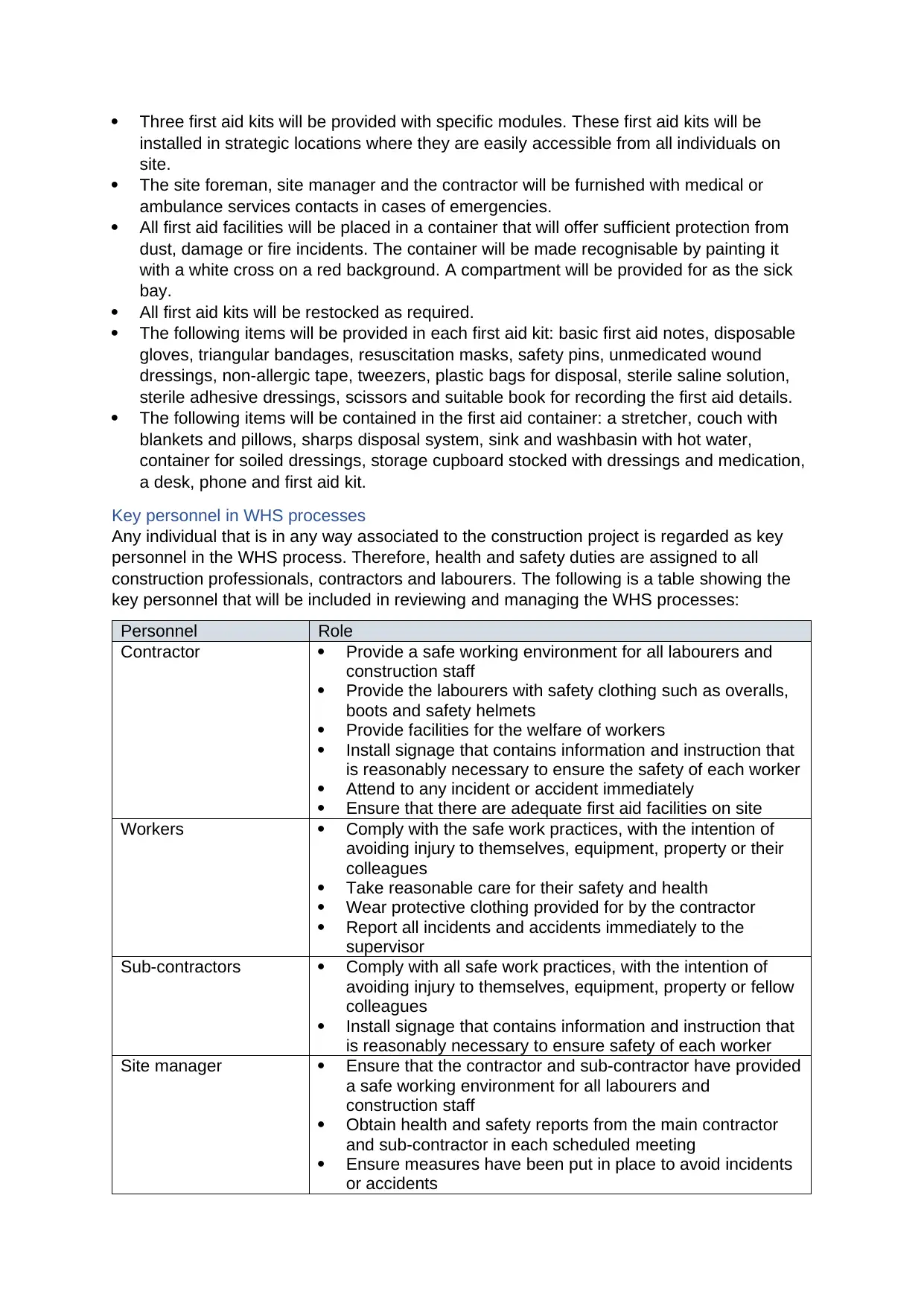
Three first aid kits will be provided with specific modules. These first aid kits will be
installed in strategic locations where they are easily accessible from all individuals on
site.
The site foreman, site manager and the contractor will be furnished with medical or
ambulance services contacts in cases of emergencies.
All first aid facilities will be placed in a container that will offer sufficient protection from
dust, damage or fire incidents. The container will be made recognisable by painting it
with a white cross on a red background. A compartment will be provided for as the sick
bay.
All first aid kits will be restocked as required.
The following items will be provided in each first aid kit: basic first aid notes, disposable
gloves, triangular bandages, resuscitation masks, safety pins, unmedicated wound
dressings, non-allergic tape, tweezers, plastic bags for disposal, sterile saline solution,
sterile adhesive dressings, scissors and suitable book for recording the first aid details.
The following items will be contained in the first aid container: a stretcher, couch with
blankets and pillows, sharps disposal system, sink and washbasin with hot water,
container for soiled dressings, storage cupboard stocked with dressings and medication,
a desk, phone and first aid kit.
Key personnel in WHS processes
Any individual that is in any way associated to the construction project is regarded as key
personnel in the WHS process. Therefore, health and safety duties are assigned to all
construction professionals, contractors and labourers. The following is a table showing the
key personnel that will be included in reviewing and managing the WHS processes:
Personnel Role
Contractor Provide a safe working environment for all labourers and
construction staff
Provide the labourers with safety clothing such as overalls,
boots and safety helmets
Provide facilities for the welfare of workers
Install signage that contains information and instruction that
is reasonably necessary to ensure the safety of each worker
Attend to any incident or accident immediately
Ensure that there are adequate first aid facilities on site
Workers Comply with the safe work practices, with the intention of
avoiding injury to themselves, equipment, property or their
colleagues
Take reasonable care for their safety and health
Wear protective clothing provided for by the contractor
Report all incidents and accidents immediately to the
supervisor
Sub-contractors Comply with all safe work practices, with the intention of
avoiding injury to themselves, equipment, property or fellow
colleagues
Install signage that contains information and instruction that
is reasonably necessary to ensure safety of each worker
Site manager Ensure that the contractor and sub-contractor have provided
a safe working environment for all labourers and
construction staff
Obtain health and safety reports from the main contractor
and sub-contractor in each scheduled meeting
Ensure measures have been put in place to avoid incidents
or accidents
installed in strategic locations where they are easily accessible from all individuals on
site.
The site foreman, site manager and the contractor will be furnished with medical or
ambulance services contacts in cases of emergencies.
All first aid facilities will be placed in a container that will offer sufficient protection from
dust, damage or fire incidents. The container will be made recognisable by painting it
with a white cross on a red background. A compartment will be provided for as the sick
bay.
All first aid kits will be restocked as required.
The following items will be provided in each first aid kit: basic first aid notes, disposable
gloves, triangular bandages, resuscitation masks, safety pins, unmedicated wound
dressings, non-allergic tape, tweezers, plastic bags for disposal, sterile saline solution,
sterile adhesive dressings, scissors and suitable book for recording the first aid details.
The following items will be contained in the first aid container: a stretcher, couch with
blankets and pillows, sharps disposal system, sink and washbasin with hot water,
container for soiled dressings, storage cupboard stocked with dressings and medication,
a desk, phone and first aid kit.
Key personnel in WHS processes
Any individual that is in any way associated to the construction project is regarded as key
personnel in the WHS process. Therefore, health and safety duties are assigned to all
construction professionals, contractors and labourers. The following is a table showing the
key personnel that will be included in reviewing and managing the WHS processes:
Personnel Role
Contractor Provide a safe working environment for all labourers and
construction staff
Provide the labourers with safety clothing such as overalls,
boots and safety helmets
Provide facilities for the welfare of workers
Install signage that contains information and instruction that
is reasonably necessary to ensure the safety of each worker
Attend to any incident or accident immediately
Ensure that there are adequate first aid facilities on site
Workers Comply with the safe work practices, with the intention of
avoiding injury to themselves, equipment, property or their
colleagues
Take reasonable care for their safety and health
Wear protective clothing provided for by the contractor
Report all incidents and accidents immediately to the
supervisor
Sub-contractors Comply with all safe work practices, with the intention of
avoiding injury to themselves, equipment, property or fellow
colleagues
Install signage that contains information and instruction that
is reasonably necessary to ensure safety of each worker
Site manager Ensure that the contractor and sub-contractor have provided
a safe working environment for all labourers and
construction staff
Obtain health and safety reports from the main contractor
and sub-contractor in each scheduled meeting
Ensure measures have been put in place to avoid incidents
or accidents
⊘ This is a preview!⊘
Do you want full access?
Subscribe today to unlock all pages.

Trusted by 1+ million students worldwide
1 out of 18
Related Documents
Your All-in-One AI-Powered Toolkit for Academic Success.
+13062052269
info@desklib.com
Available 24*7 on WhatsApp / Email
![[object Object]](/_next/static/media/star-bottom.7253800d.svg)
Unlock your academic potential
Copyright © 2020–2025 A2Z Services. All Rights Reserved. Developed and managed by ZUCOL.




